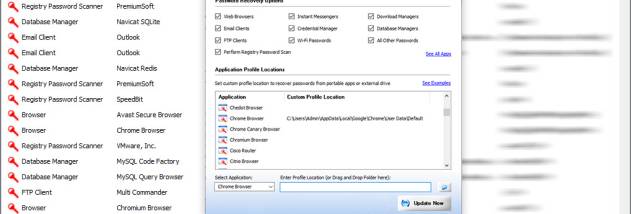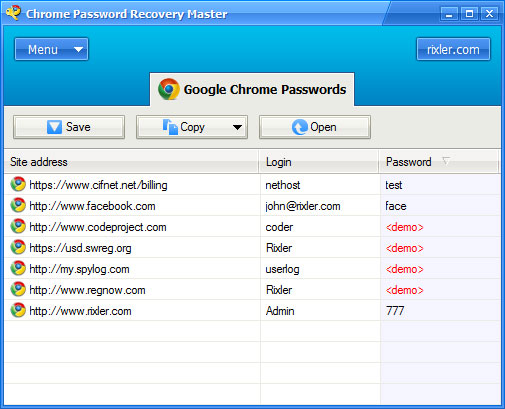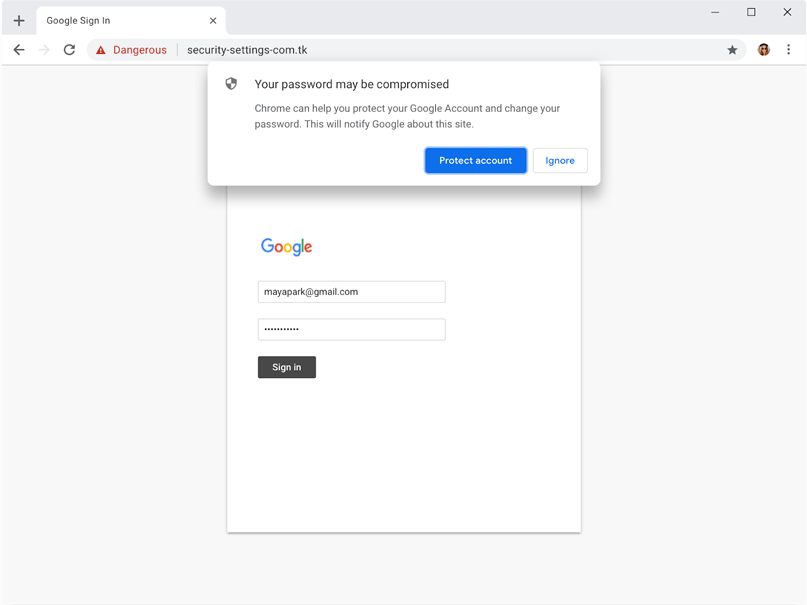- Find Google Password In Chrome
- One Password Google Chrome Login
- Forgot Password For Google Chrome
- How To Add One Password To Chrome
- Google also offers the Password Checkup extension for Chrome, which it’s building into the browser, but this isn’t as powerful as the similar features built into password managers. RELATED: The Best Way to Tackle the LastPass Security Challenge. Storing More Than Passwords. Password managers let you store more than just passwords.
- I don't understand why this extension is being criticized so harshly. I wanted a master password on Chrome like FireFox has and this filled the bill. Once installed, you create a password and then Chrome closes. When you reopen Chrome, you are prompted for a password. If you don't enter one, Chrome closes. You cannot bypass it with ESC.
Nowadays, it is very convenient to have your browser remember your login information, so that you do not have to keep in mind and type in all your passwords every time. Moreover, if you are using Chrome or Firefox, you can synchronize your credentials on multiple devices if you sign in into these browsers with one of your emails. Yes, it is convenient, but sometimes it may happen so that you need to login to a web site, social network or a service from a device that does not have your passwords stored, like from a mobile device or from a computer that you do not own, but you just cannot recall your login and password. I am sure you have experienced this situation at least once. We will tell you where you can look for your passwords saved in Chrome and/or Firefox.
To check for your passwords in Google Chrome, first click on button at the top right of the browser window and choose “Settings”.
In the next window, click on the link, saying “Show advanced settings…”. It is at the bottom of the page.
One of the missing items in Chrome is a Supervisor profile which used to be handy in preventing others from snooping on your browser activity. What Are the Current Options in Chrome To lock Google Chrome with passwords, you were once able to adjust the guest settings from chrome://flags/.
Chrome will now open for you a big list of system options. We are looking for the section saying “Passwords and forms”. Once found, click on “Manage passwords” link.

This will open the list of sites with all logins and passwords ever saved by Chrome under your account. Just search and select the line with desired web resource and click “Show button”. Chrome will ask you to enter your OS password for authentication and that’s it. Now you remember your password again, till next time.
Now let’s check how the same thing works in Firefox. Click on button (I guess I saw this button somewhere, but cannot recall where…) at the top right of the browser window and choose “Options”.

Now navigate to “Security” tab on the left and click on “Saved Logins…” button.
This will open the list with logon information saved by Firefox. The only thing left is to click on “Show Passwords” button to have your memory restored.
The list of all your passwords will be displayed in a separate column.
Wish you good memory and secure passwords.
- Posted by Author
- On March 10, 2016
- 0 Comments
To celebrate 10 years of the Chrome browser, Google came up with a revamped interface which is more functional and loaded with new features. Some visual changes included new rounded tabs, the ability to add customized wallpaper without installing any extensions, and a new profile icon. One particular feature that caught user's attention is the updated password manager.
Chrome has had a password manager and autofill option for a long time, but they were not useful and left a lot to be desired. The revamped password manager is a start, but I am still not going to use it.
Don't get me wrong; I am a Google fanboy. So much so that I have spent the better part of the last month moving everything to Drive, Keep Notes, and Gmail. But I am not a fan of the Chrome Password Manager.
By the end of the post, if you feel the same way, then you can check out how to disable it.
Let’s begin.
1. What About Other Browsers
Find Google Password In Chrome
While Chrome leads the race with about 60% market share on desktop/laptop and mobile platforms, it is not the only browser around. The remaining 40% of users rely on Firefox, Edge, Safari, Opera, UC Browser, and IE (yes, people still use it!).
If you are a Chrome user, you may use it as your default password manager. However, those people who use Chrome in tandem with other browsers might feel limited by this browser-specific password manager.
Other password managers like LastPass, Dashlane, and 1Password support all browsers and operating systems. And that gives you more freedom and control over the login credentials of your digital accounts. Using Chrome Password Manager seems like a restrictive and highly limiting idea at this moment. What if you wanted to use another browser in the future?
2. What About Smartphones
Looking at the Chrome Password Manager, the first question that popped into my mind — does it work on smartphones too? I own an Android and an iPhone since I enjoy using both the platforms equally. When I launched Chrome on my iPhone, the password manager was missing. Even Chrome on Android does not have the Password Manager. That's a bit surprising since Google owns Android.
Such absence limits Chrome Password Manager’s functionality by a vast margin. Millions of people use their smartphones to surf the web, watch videos, binge-watch Netflix, and shop online. Google’s decision to leave mobile OSes out of the equation has left me perplexed. While I am sure Google must have had their reasons, I hope the feature launches for mobile platforms soon.
Also on Guiding Tech
The Complete Guide to Using Chrome Password Manager
Read More3. What About Apps
Google is all about the integration of its services inside its apps and those developed by others. Surprisingly, not the case with Chrome’s password manager. No, it won’t work with any of the apps because it is tied to the browser.
A third-party app will allow you to autofill passwords and other details with the tap of a button without you having to change the screen or even open the password manager app. Sure, they charge a premium but the convenience they offer more than makes up for it.
4. Useful Features You May Need
Chrome Password Manager, like most Google products, is free to use. Third-party password managers like LastPass and Dashlane charge money but offer plenty of features along with cross-platform support in return to justify the price tag. For example, LastPass costs $2 per month, and you get support for all the popular browsers, operating systems, and mobile apps.
You can use the fingerprint sensor on your phone to quickly log in to your favorite sites or apps. There is no way to create and store secured notes in Chrome Password Manager as some other password managers offer.
Also on Guiding Tech
Top 3 Free And Secure Password Managers For iPhone

One Password Google Chrome Login
 Read More
Read More
5. All Eggs in One Basket
Google offers all of its apps and services for free in exchange for your data that it collects and retains to deliver a personalized experience. Whether you are using Gmail or Chrome, Google always wants to know more about you by learning your usage patterns. That is a scary part of digital life.
I trust Google as a company and believe that my data is safe on their servers. But the idea of saving all my passwords on their servers scares the living daylights out of me. It’s like keeping all your eggs in the same basket that might get stolen in one full swoop. It is better to store some things on a different server and with a different company, one that is not owned by Google.
I like Google to the point that I recently deleted pretty much all third-party apps in favor of Google apps. But I must draw a line here. Especially after Google kept mum about a major Google+ security flaw that could expose users' personal information.
6. Disable Chrome Password Manager
If you still want to use Chrome Password Manager then by all means proceed. However, if you need more features, options, and control over your passwords, then follow the steps below to disable it.
Launch Chrome on your desktop computer, and you should be already logged in to Google. Click on your profile pic on the upper-right corner of Chrome and click on Passwords. There are two options available here:
- Offer to save passwords
- Auto Sign-in
Forgot Password For Google Chrome
Enabling the first one will show a pop-up to generate a secure password every time you are registering a new account on a website. The second option will let you sign in to those websites automatically, without having to fill in the user ID and password by clicking on the sign in button.
Disable both of them to stop Chrome from offering to generate and save the password for signing into sites automatically.
It’s Not There Yet
How To Add One Password To Chrome
As I have mentioned earlier, I like using Google apps and services, but the Chrome Password Manager is not there yet. At least not for me. The password manager lacks mobile OS compatibility. And I doubt it will ever offer support for the third-party browser if not mobile apps. Maybe Google will launch a password manager app in the future?
Next up: Looking for the best password manager to secure your digital life? Check the link below to know more about Dashlane.
The above article may contain affiliate links which help support Guiding Tech. However, it does not affect our editorial integrity. The content remains unbiased and authentic.
Read Next
6 Tested Ways to Fix Chrome Password Manager Not Working Issues
Is the Chrome
